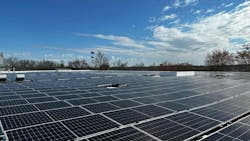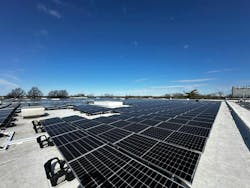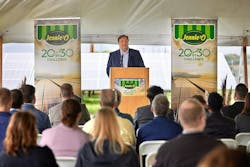Here Comes the Sun: Manufacturers Share Their Solar Power Journeys
Over the past few years, solar manufacturers have invested billions into domestic production facilities, and it’s paying off. The U.S. solar market added a record 32.4 gigawatts (GW) of new electric generating capacity in 2023, according to Solar Energy Industries Association. That's an increase of 51% over 2022.
But manufacturers aren't just producing solar systems, they are using them as well, and for good reason: to meet aggressive sustainability targets, both internally generated and federally encouraged. Plus, the industrial sector uses a lot of energy: It accounted for 33% of total domestic energy consumption in 2022, according to the U.S. Energy Information Administration.
Earth Day, which annually falls on April 22, provides a good opportunity to share how two manufacturers took the initiative to reduce their carbon footprint and found a way to make solar power work for them.
R.A Jones: Maximizing Efficiency
R.A Jones specializes in the design and manufacture of packaging machinery and equipment, and its Kentucky facility recently underwent a makeover. The plant is making history as the first North American company in Coesia Group to install solar panels.
Two R.A Jones employees sparked the interest in using rooftop solar at the Kenton County manufacturing plant, explains Jonathon Titterton, CEO of Coesia Americas and R.A Jones. “They actually took it upon themselves to start researching ‘Were we eligible?’ ‘Were we a good site for this?’ Did it make sense in Northern Kentucky?’”
After researching and making contacts with local companies, the employees made a presentation to the global leadership team during an annual visit from Coesia COO Davide Castiglioni.
“We actually presented it to him, and he goes ‘Perfect timing, R.A Jones! Our president has created some funds for purely sustainable projects,’” Titterton says.
Coesia has a clear focus on its ESG targets, he says.
By 2030 Coesia aims to:
- Achieve carbon neutrality of GHG scope 1-2
- Reduce GHG scope 3 by at least 25%
- Source 100% of its electricity from renewable sources
The new solar installation at R.A Jones marks a big step in bringing renewable power to its U.S. companies.
“We have a big facility here, 250,000 square feet,” he says. R.A Jones installed over 3,700 panels, covering around 85% of the roof surface. “We’re not using any of our parking facility, we’re not using any of our green space [for the solar panels]. It’s just maximizing the use of our facility.”
Through studies and structural surveys, R.A Jones ensured that its building was fit for the project and determine the optimal panel angle.
R.A Jones collaborated with local company Melink Solar to design and build the panels for the Kenton County facility.
The panel system is in the completion stage, after less than 18 months. It is expected to produce over 2 million kWh of clean energy each year, which is more than 50% of the plant’s energy needs for the first year.
Once fully operational, the system will generate 100% zero-carbon electricity at the manufacturing facility during the 30-year life cycle of the installation. “We’ll be offsetting 330,200 tons of CO2,” Titterton says.
R.A Jones is kickstarting Coesia’s renewable efforts in North America, but they’re not done just yet, according to Titterton, who shared some “hot off the press” news.
“We’re so happy with what’s happening here, we’re going to do the same in our other facility in Davenport, Iowa,” he says.
Jennie-O: Sharing Is Caring
Hormel Foods isn’t new to the solar space, with multiple plants already taking advantage of renewable energy. The corporation recently expanded that list with the addition of an 8-acre solar field at its Jennie-O Turkey Store plant in Montevideo, Minnesota.
The field is projected to generate 3.2 million kWh annually, supplying around 10% of the facility’s industrial power. Furthermore, a portion of the project is allotted to the surrounding community.
Driving Hormel to establish these types of projects is their 20 By 30 Challenge, a set of 20 goals to be achieved by 2030.The manufacturer strives to match 100% of its energy with renewable sourcing and meet its greenhouse gas reduction targets, which were recently validated by the Science Based Targets initiative (SBTi).
Hormel considers a variety of factors, including available space and pricing, when vetting the location and viability of its next project.
“One of the things we look at our manufacturing locations is where can we expand our facility in the future because we don’t want to install anything that might interfere with future growth of the operation,” says Tom Raymond, Hormel Foods’ director of environmental sustainability. “The Montevideo plant gave us a really excellent access to the section of land.”
After deciding the Montevideo Jennie-O plant was a match, the company sought proposals from potential partners.
“When you get that partner, then there’s a long series of design and measurement phases,” he says. “Some of that involves contracting between the parties, discussions with the utilities on interconnections of getting our power to our plant … That all takes place very early in the process, and that is probably the singular hardest stage.”
For the Montevideo project in particular, the company added a unique feature to support its team members and surrounding community.
“The utility provider limits us to a certain amount of power, so 1 megawatt of power is all that we can put in to support our building needs,” says Raymond. However, the land developer gave the company an option to have two megawatts, allowing Hormel to devote the extra megawatt of solar out into the grid.
This arrangement allows Hormel’s team members and the surrounding community to subscribe to the renewable power for utility savings.
Raymond estimates that from the initial idea to the ribbon cutting in September 2023, the project took close to three years to complete. He attributes the length of the timeline to two challenges.
“One of those we just can’t control and that’s with supply chain issues coming through out of pandemic times,” he says. “And then the second piece is that interconnection, getting the final approval to start the system up takes time.”
Despite these factors, there were no unexpected issues that the company wasn’t prepared for, and Raymond describes the project as very smooth from start to finish.
“I’m really proud of what the plant and our partners did during the construction phases to make this successful.”
The solar field will reduce greenhouse gas emissions by around 2,265 metric tons annually, the equivalent of removing over 500 gasoline powered passenger vehicles from the road for a year, according to Hormel.
Hormel plans to continue embarking on renewable projects, constantly reviewing and revisiting sites to assess their validity for such a project.
“Resiliency, price control on utility supplied electricity, there’s a couple really solid reasons to be looking into renewables as a business,” he says.
Earlier solar power coverage from IndustryWeek and other Endeavor Business Media publications:
- Clean Manufacturing Could Strengthen DoD's Industrial Strategy
- Local Leadership Guides Worldwide Plant Sustainability at ABB
- EnGoPlanet and Calhoun County Partner on Solar Streetlight Project for Texas Public Parks
- Vast Progresses on Developing 288 MWh Concentrated Solar Thermal Power Plant in South Australia with Engineering Contracts
- ELM Microgrid & Solar Celebrates Grand Opening of Texas Manufacturing Site
- Battery Storage and Solar Project Planned for Puerto Rico
- Why Are Some Companies Backing Off Their Sustainability Commitments?
- Repsol Finishes Texas Solar Plant with Almost a Million Panels
- Navy to Evaluate Solar Power for Submarines
About the Author
Anna Smith
News Editor
News Editor
LinkedIn: https://www.linkedin.com/in/anna-m-smith/
Bio: Anna Smith joined IndustryWeek in 2021. She handles IW’s daily newsletters and breaking news of interest to the manufacturing industry. Anna was previously an editorial assistant at New Equipment Digest, Material Handling & Logistics and other publications.



